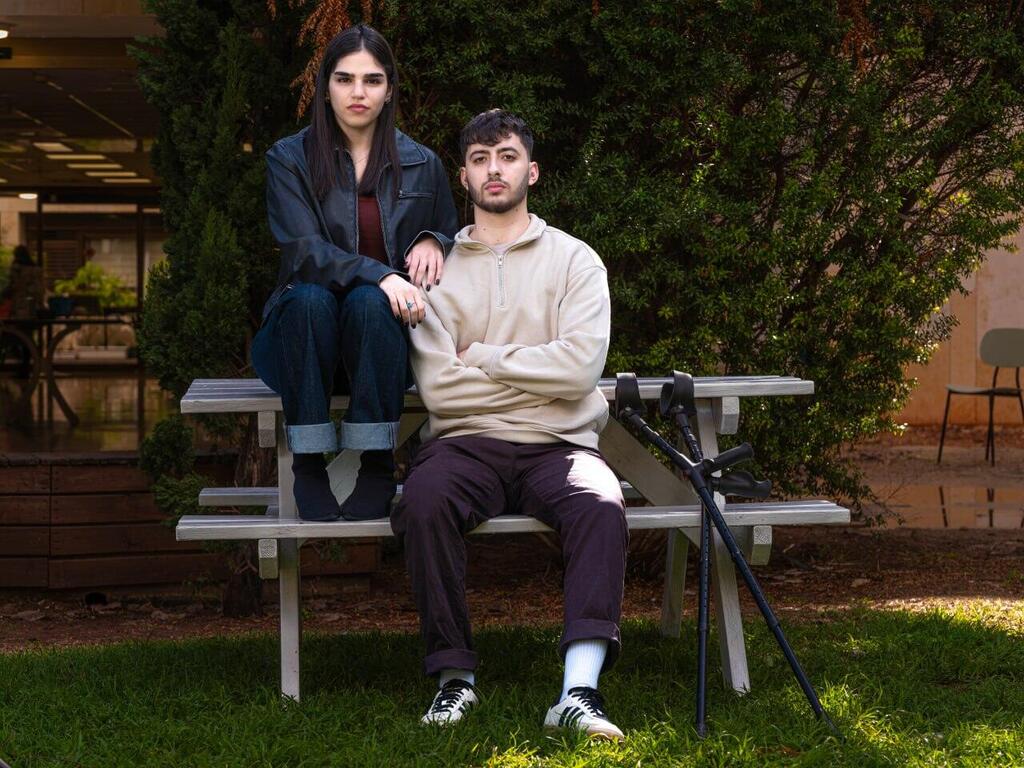At first glance, he may seem out of place—a large man in his late 40s standing among a group of young people, the age of his soldier daughter. But then you notice the portable vacuum pump connected to him by a tube, and it makes sense. Later, during the photo shoot for this article, Superintendent Mati Tsarfati lifts his shirt to reveal a long scar running down his back, marking where the AK-47 bullet pierced him. Tsarfati, who was the operations officer of the Sderot police station, is one of the few injured from October 7 who is still in rehabilitation.
Eight of his subordinates fell that morning. His story, and the stories of others—like Ron, who was injured in Gaza on December 8, 2023, and has been in recovery for over a year and two months, and Eran, who completed his rehabilitation after being injured in Khan Younis and transitioned to outpatient treatment—highlight the continuing struggles of those injured in battle. Their war persists, fought through countless challenges, not all of which end in victory.
Superintendent Tsarfati was wounded by sniper fire after neutralizing several terrorists. He vividly recalls the circumstances of his injury. “I arrived at the station, and just as I was pulling into the parking lot, a Nukhba terrorist appeared in front of me and fired five bullets, hitting my car.”
Tsarfati recounts the battle in great detail, but he emphasizes the bravery of the officers who fell, some of whom fought right by his side. “After the first encounter, where we neutralized two terrorists, I met with the district commander at the time, Deputy Commissioner Amir Cohen. Together, we charged toward the station and eliminated five more terrorists. Then I saw that one of the terrorists we had hit was still alive and trying to lift his weapon toward the district commander, so I shot him in the head. At that moment, another terrorist shot me—one bullet hit my chest, and another hit my leg. The community security officer, Ronen Gabai, along with a National Counter-Terrorism Unit officer, dragged me behind a shelter.”
He lay there for three hours, bleeding but fully conscious. “I called my wife on video, told her I was injured, that I love her and the kids, and that I would do everything to stay alive.” He kept his promise.
The moment Tsarfati was wounded
Superintendent Tsarfati was evacuated to Barzilai Medical Center, where the medical team fought to save his life. “When I woke up, they tried to shield me from the magnitude of the loss. But for me, the loss was overwhelming. These were my subordinates, and losing them hit me hard.”
When his condition stabilized, Tsarfati was transferred to Soroka Medical Center in Be’er Sheva. “I underwent a very complex surgery led by Dr. Shlomo Yaron Yishai, Professor Yael Refaeli, and Dr. Assaf Aker. They stitched up my lung, replaced six ribs with titanium ones, and also replaced my shoulder blade. From there, I was transferred to rehabilitation at Soroka under the supervision of Dr. Yuli Trager.”
The first chapter of his rehabilitation ended on January 1, 2024. “I was discharged from Soroka, transitioned to outpatient rehab, and simultaneously, Commander Yogev Attias, head of the Sa’ar Division (Public Order, Defense, and Sovereignty), appointed me as the operations officer.” In April of that year, Tsarfati began his new role. In August, he went on a Mediterranean cruise with his family. During the trip, he experienced unbearable pain in his wounded leg. “When we returned to Israel, they opened up my pelvis to take a piece of bone to place in my leg. As a result, I developed a severe pelvic infection and had to undergo 23 surgeries. I’ve been here at Soroka for four months now, attached to a VAC device that drains the wound, so I can’t leave the hospital.”
Tsarfati is both physically and mentally strong. In the past, he completed two full marathons. “I know I won’t be running marathons again, but as soon as they remove the tube, I’ll get back to training.”
Love formed amid rehabilitation
Rehabilitation is often misunderstood as a steady path of improvement, but the reality is far from that. “Rehabilitation is one step back, two steps forward,” says Ron Sapir, 22, from Moshav Zitan, a commander in the 603rd Engineering Battalion of the IDF. Sapir was injured by an explosive device on December 14, 2023, in southern Gaza. The incident claimed the life of Sergeant Oz Shmuel Ardi, who was sitting beside him in the Namer APC. “I looked at my leg and realized it was barely attached, just a small piece of quadriceps muscle. My bone flew off in the explosion.”
Ron was classified as critically injured. He spent a month at Soroka, where doctors saved his leg from amputation. “When I woke up five days later, I saw my mom beside me. I asked her, ‘Do I still have my leg?’ She said, ‘Yes.’ Then I fell asleep again.”
He was later transferred to the “Back to Life” rehabilitation wing at Sheba Medical Center. “Rehabilitation lifts you up when you’re surrounded by other injured soldiers, but when they start getting discharged and you’re left behind, it’s hard. You’re happy for them, but at the same time, you think, ‘What about me?’ It burns you up. Triple amputees who arrived after me were discharged before me. I also struggled with infections and was on antibiotics for nearly a year. I held on thanks to my family, especially my twin sister Shai, who was with me throughout rehab, and my girlfriend Maya. She’s the best thing that came out of this experience.”
Ron met Maya Dimri, a law student his age, during rehab. “I had a crush on her back in high school,” Ron admits. “Back then, I wasn’t so interested,” Maya laughs, recounting how they reconnected. “My mom came to Sheba to visit injured soldiers and bring gifts. She happened to pass by Ron’s room. He recognized her and shouted, ‘Maya’s mom! Maya’s mom!’ Suddenly, I get a picture of Ron from my mom.”
Ron: “I thought to myself, ‘What do I have to lose?’ I messaged her and asked her to visit me.” The rest is history. They’ve been a couple for six months now. “But because of everything we’ve been through together, it feels like ten years.”
Get the Ynetnews app on your smartphone: Google Play: https://bit.ly/4eJ37pE | Apple App Store: https://bit.ly/3ZL7iNv
Ron: “We’re looking for an apartment. Mention in the article—three rooms with an elevator or on the ground floor, close to Sheba.”
So when’s the wedding?
“As soon as I can kneel, I’ll propose.”
Eran, a 22-year-old reservist in the Yahalom Engineering Unit, is also undergoing rehabilitation at Soroka. While attached to the 13th Battalion of the Golani Brigade, he was wounded during a maneuver on the second night of Hanukkah. “We were clearing a building in northern Gaza, preparing it for use, when I got hit in the leg by a bullet.”
Eran’s injury, while seemingly minor, turned severe. He ended up at Soroka with a shattered bone, a torn artery, and recurring infections. “I’ve had 12 surgeries so far. They took bone from my pelvis to replace the missing bone, muscle from one area, an artery from another, and skin from somewhere else,” he says, pointing to the scars on both legs. “Two months ago, they did another bone graft, this time from my thigh. You see the light, and then you go back.”
In October, Eran began studying civil engineering at Ben-Gurion University, near the hospital. Beyond pursuing a profession, the studies are part of his rehabilitation. “I wake up at seven in the morning, do an hour of physiotherapy, and start classes at nine. Until last week, I was getting around campus on a mobility scooter; now, I use crutches. Studying distracts me from constantly dwelling on the negative.”
Before enlisting, Eran was a professional athlete in tumbling (acrobatic gymnastics practiced on mats). He placed second in Israel and represented the country at the world championship in Russia. He shows a video of himself doing nine consecutive flips in the air. “I’ll get back to it, even if not at the same level,” he promises. Watching him fight to reclaim his life, it’s hard not to doubt his determination.







